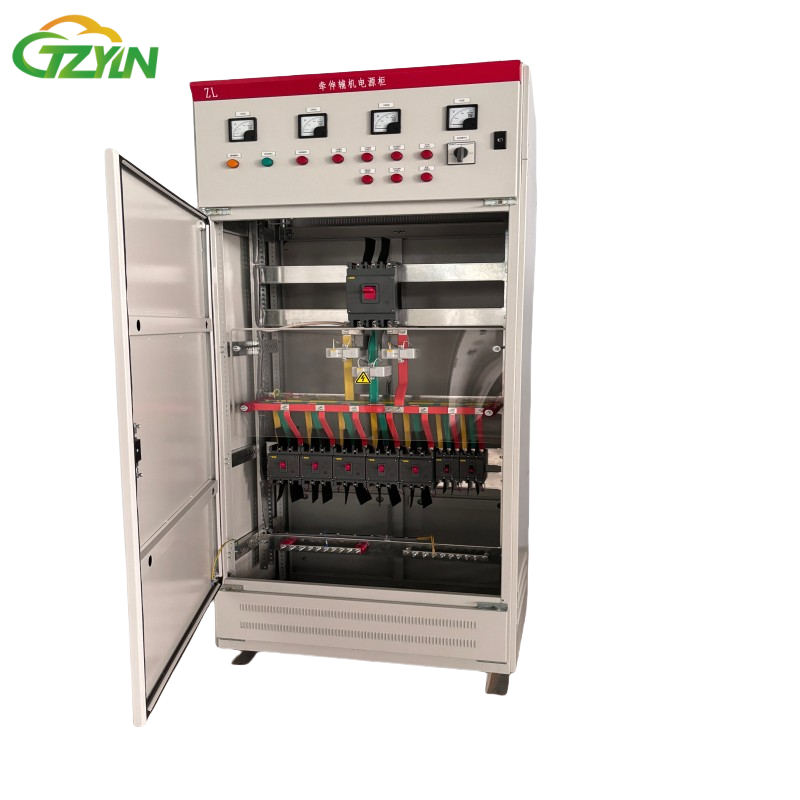Three-Phase AC Systems play a vital role in modern power distribution. They ensure the seamless delivery of electricity by providing a steady and balanced flow of power. This system enhances efficiency, reduces energy losses, and supports reliable operations across various sectors. Its ability to handle large loads makes it indispensable for industrial machinery, commercial equipment, and even residential applications. By minimizing vibrations and maintaining consistent performance, it has become the backbone of electrical infrastructure worldwide.
What Are Three-Phase AC Systems?
Definition and Basic Principles
Three-Phase AC Systems represent a method of electrical power generation, transmission, and distribution that uses three alternating currents. These currents operate at the same frequency but are 120 degrees out of phase with each other. This phase difference ensures a continuous and balanced flow of power, which is essential for maintaining stability in electrical systems. Engineers and electricians often describe these systems as the backbone of modern power infrastructure due to their efficiency and reliability.
The basic principle behind Three-Phase AC Systems lies in their ability to deliver power more effectively than single-phase systems. By using three separate currents, they reduce energy losses and provide a smoother transfer of electricity. This design minimizes fluctuations, ensuring consistent performance for equipment and machinery. The system's structure also allows for the use of smaller and lighter wiring, which reduces material costs without compromising functionality.
How Three-Phase AC Systems Work
Three-Phase AC Systems operate by generating three alternating currents that are evenly spaced in time. These currents are produced by rotating a magnetic field within a generator. As the magnetic field rotates, it induces voltage in three separate windings, each positioned 120 degrees apart. This configuration creates three distinct waveforms that work together to deliver a constant supply of power.
The system's design ensures that at any given moment, at least one of the three phases is at its peak voltage. This overlapping of waveforms results in a steady flow of energy, which is particularly beneficial for powering motors and other heavy machinery. The balanced nature of the system also reduces wear and tear on equipment, extending its lifespan and improving overall efficiency.
Key Differences Between Three-Phase and Single-Phase Systems
Three-Phase AC Systems differ significantly from single-phase systems in terms of performance and application. Single-phase systems use only one alternating current, which limits their ability to handle large loads. In contrast, Three-Phase AC Systems distribute power more evenly, making them ideal for industrial and commercial settings.
Another key difference lies in efficiency. Three-Phase AC Systems deliver power at a constant rate, reducing energy losses and ensuring smoother operation. Single-phase systems, on the other hand, experience periodic drops in voltage, which can lead to inefficiencies and increased energy consumption. Additionally, three-phase systems require less conductor material for power transmission, further enhancing their cost-effectiveness.
In practical applications, Three-Phase AC Systems are commonly used for heavy-duty equipment and large-scale operations, while single-phase systems are more suitable for residential use and smaller appliances. This distinction highlights the versatility and importance of three-phase systems in modern power distribution.
Advantages of Three-Phase AC Systems
Efficiency and Performance
Three-Phase AC Systems excel in delivering superior efficiency and performance. Their design ensures a continuous and balanced flow of power, which minimizes energy losses during transmission and distribution. This efficiency becomes particularly evident in industrial settings, where large machinery and equipment demand consistent energy supply. By maintaining a steady voltage, these systems reduce fluctuations that could otherwise disrupt operations or damage equipment.
The performance of Three-Phase AC Systems also stands out in motor-driven applications. Motors powered by this system operate more smoothly, with reduced vibrations and noise. This smooth operation not only enhances the lifespan of the machinery but also improves productivity by minimizing downtime caused by mechanical failures. The ability to handle heavy loads without compromising performance makes these systems indispensable in industries requiring high power output.
Cost-Effectiveness
Three-Phase AC Systems offer significant cost advantages over single-phase systems. Their ability to transmit power efficiently reduces the need for excessive conductor material, such as copper or aluminum. This reduction in material usage lowers installation costs, making them a more economical choice for large-scale power distribution.
In addition to lower installation expenses, these systems also contribute to long-term savings. Their efficient energy transmission reduces electricity losses, leading to lower operational costs. Businesses and industries benefit from these savings, as they can allocate resources to other critical areas. Furthermore, the durability and reliability of Three-Phase AC Systems minimize maintenance expenses, adding to their overall cost-effectiveness.
Reliability and Scalability
Reliability remains a cornerstone of Three-Phase AC Systems. Their balanced power delivery ensures uninterrupted energy supply, even in demanding conditions. This reliability proves crucial in industries where power outages or fluctuations could result in significant financial losses or safety risks. The overlapping waveforms in the system guarantee that power remains available at all times, enhancing operational stability.
Scalability further enhances the appeal of these systems. As businesses grow and their energy needs increase, Three-Phase AC Systems can easily accommodate higher loads without requiring a complete overhaul of the infrastructure. This adaptability makes them an ideal choice for industries and commercial establishments planning for future expansion. Their ability to scale efficiently ensures that they remain a viable Solution for both current and future power distribution requirements.
Real-World Applications of Three-Phase AC Systems
Industrial Applications
Three-Phase AC Systems dominate industrial environments due to their ability to handle high power demands efficiently. Factories and manufacturing plants rely on these systems to operate heavy machinery, such as conveyor belts, compressors, and large motors. The consistent power delivery ensures smooth operation, reducing the risk of mechanical failures. Industries also benefit from the system's ability to minimize energy losses, which translates to lower operational costs.
In addition, Three-Phase AC Systems support the operation of equipment requiring precise control, such as CNC machines and robotic arms. These systems provide the stability needed for such applications, ensuring accuracy and reliability. Their scalability allows industries to expand operations without overhauling the existing electrical infrastructure, making them a practical choice for long-term growth.
Commercial Applications
Commercial establishments, including shopping malls, office buildings, and data centers, depend heavily on Three-Phase AC Systems. These systems power elevators, HVAC units, and lighting systems, ensuring uninterrupted Service for customers and employees. The balanced power distribution reduces the likelihood of voltage drops, which could disrupt operations or damage sensitive equipment.
Data centers, in particular, require a stable and reliable power supply to maintain servers and cooling systems. Three-Phase AC Systems meet these demands by delivering consistent energy, preventing downtime that could lead to significant financial losses. Their cost-effectiveness also appeals to commercial entities, as they reduce energy expenses while maintaining high performance.
Residential Applications
While single-phase systems are common in residential settings, Three-Phase AC Systems are increasingly used in larger homes and apartment complexes. These systems support high-energy appliances, such as central air conditioning units, electric vehicle chargers, and water heaters. Their ability to deliver power efficiently ensures that households experience fewer interruptions and lower energy bills.
Apartment buildings benefit from Three-Phase AC Systems by distributing power evenly across multiple units. This setup reduces the strain on the electrical network, enhancing safety and reliability. Homeowners with advanced energy needs, such as those using renewable energy systems or smart home technologies, also find these systems advantageous due to their scalability and efficiency.
Three-Phase AC Systems provide unmatched benefits in power distribution. Their efficiency ensures minimal energy loss, while their cost-effectiveness reduces material and operational expenses. Reliability remains a key advantage, offering consistent performance across diverse applications. These systems play a pivotal role in powering industrial, commercial, and residential sectors, making them indispensable in modern infrastructure. For larger-scale energy needs, they offer a scalable and practical solution. Businesses and individuals should consider adopting these systems to enhance energy efficiency and support future growth.




